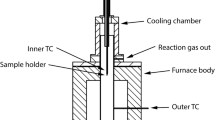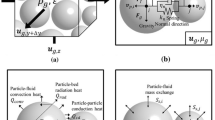Abstract
A finite element analysis is developed for nontopochemical reduction of a porous iron oxide pellet. The reduction kinetics are essentially the same as those used by Trushenski, Li and Philbrook. However, several novel features arise in the present analysis. The computational technique used in this analysis provides an explicit way of calculating gas profiles for each step of the computations. To a limited extent multicomponent gas mixtures (either carbon monoxide, carbon dioxide and inert gases; or hydrogen, steam and inert gases) can be accomodated as the reducing agent. A corresponding analysis for direct reduction of iron oxide in a countercurrent shaft furnace assumes adiabatic conditions to prevail in the furnace as opposed to the usual isothermal assumption. The analysis assumes steady-state operation of the furnace, and plug flow of gas and solid. Profiles of gas and solid temperatures, degree of reduction of iron oxide pellets, bulk gas and solid compositions are calculated.
Similar content being viewed by others
Reference
T. E. Dancy:Met. Trans. B, 1977, vol. 8B, p. 201.
G. G. Carinci and D. C. Meissner:E/MJ Operating Handbook of Mineral Processing, 1976, p. 292.
K. Li:Blast Furnace, vol. 19, p. 153, Coke Oven and Raw Materials Committee, TMS-AIME, 1960.
S. P. Trushenski, K. Li and W. O. Philbrook:Met. Trans., 1974, vol 5, p. 1149.
S. P. Trushenski: Ph.D. Thesis, Carnegie-Mellon University., Pittsburgh, PA, 1971.
R. L. Miller: M.S. Thesis, Carnegie-Mellon University, Pittsburgh, PA, 1968.
N. A. Warner:Trans. TMS-AIME. 1964, vol. 230, p. 163.
G. Nabi and W. K. Lu:Trans. TMS-AIME, 1968, vol. 242, p. 2471.
A. M. Cance:Trans. Faraday Soc., 1925, vol. 21, p. 176.
K. O. Yu: Ph.D. Dissertation, University of Kentucky, Lexington, KY, 1978.
H. L. Toor and H. S. Chiang:J. AICHE, 1959, vol. 5, p. 339.
H. L. Toor:J. AICHE, 1962, vol. 8, p. 70.
L. K. Peters and L. W. Richards:Atmos. Environ., 1977, vol. 11, p. 101.
Q. T. Tsay, W. H. Ray, and J. Szekely:J. AICHE, 1976, vol. 22, p. 1064.
F. J. Harvey and J. W. Clark: private communication, Westinghouse Research Laboratories, Pittsburgh, PA.
R. H. Spitzer, F. S. Manning, and W. O. Philbrook:Trans. TMS-AIME, 1968, vol. 242, p. 618.
H. B. Keller:Numerical Methods for Two-Point Boundary-Value Problems, Blaisdell Publishing Company, MA, 1968.
J. D. Lambert:Computational Methods in Ordinary Differential Equations, John Wiley & Sons, New York, 1973.
Author information
Authors and Affiliations
Additional information
K. O. YU, formerly Research Associate with the Department of Metallurgical Engineering and Materials Science, University of Kentucky.
Rights and permissions
About this article
Cite this article
Yu, K.O., Gillis, P.P. Mathematical simulation of direct reduction. Metall Trans B 12, 111–120 (1981). https://doi.org/10.1007/BF02674764
Received:
Issue Date:
DOI: https://doi.org/10.1007/BF02674764




